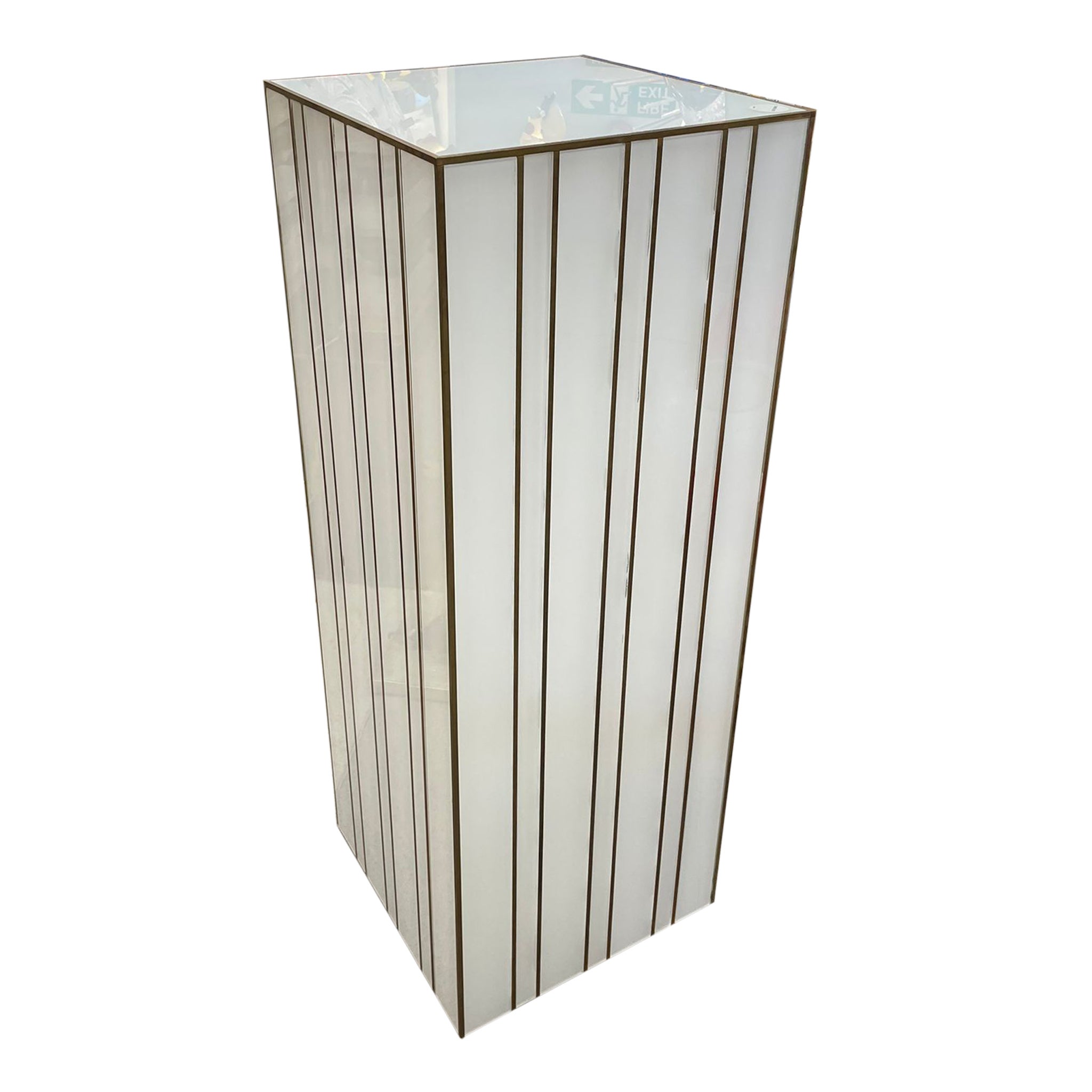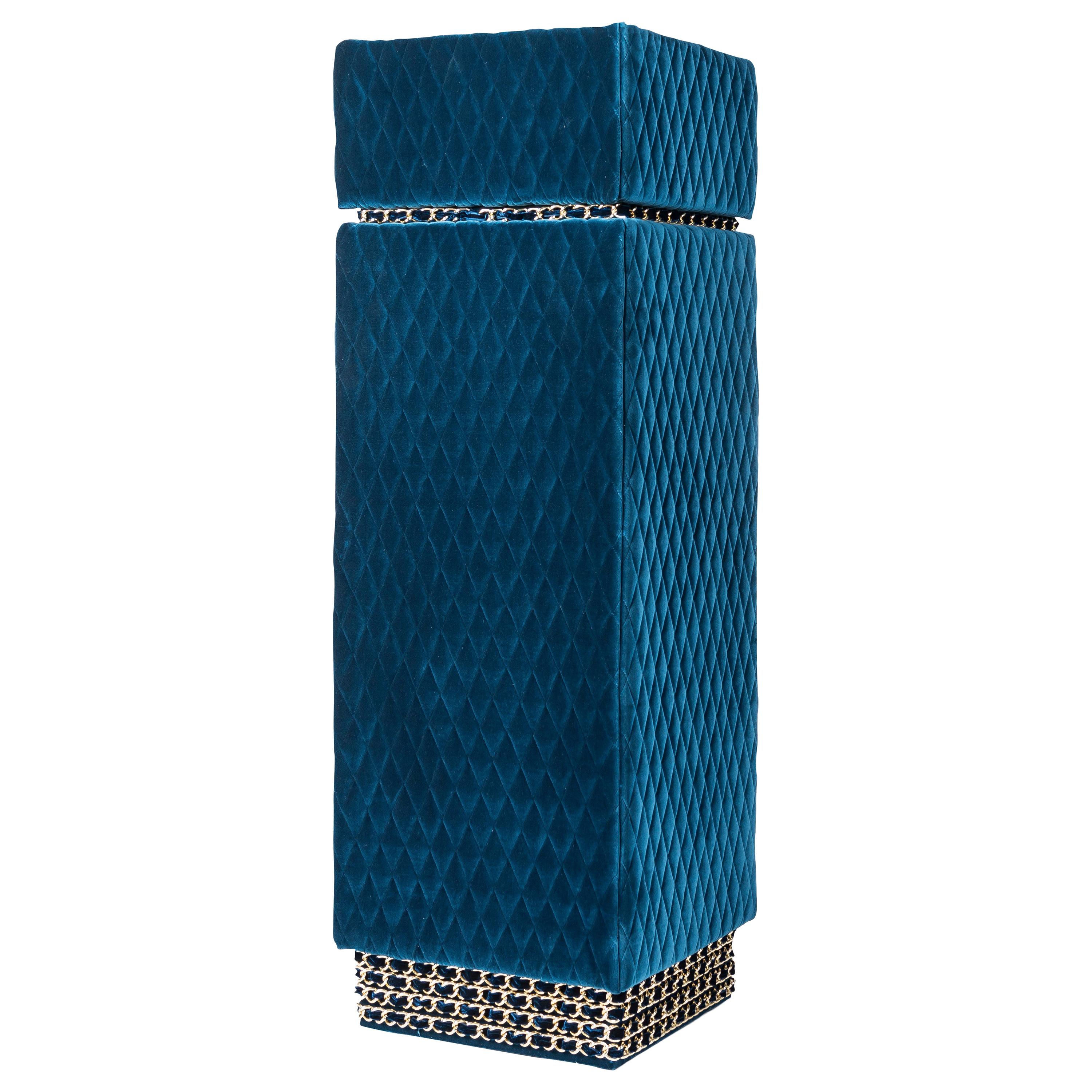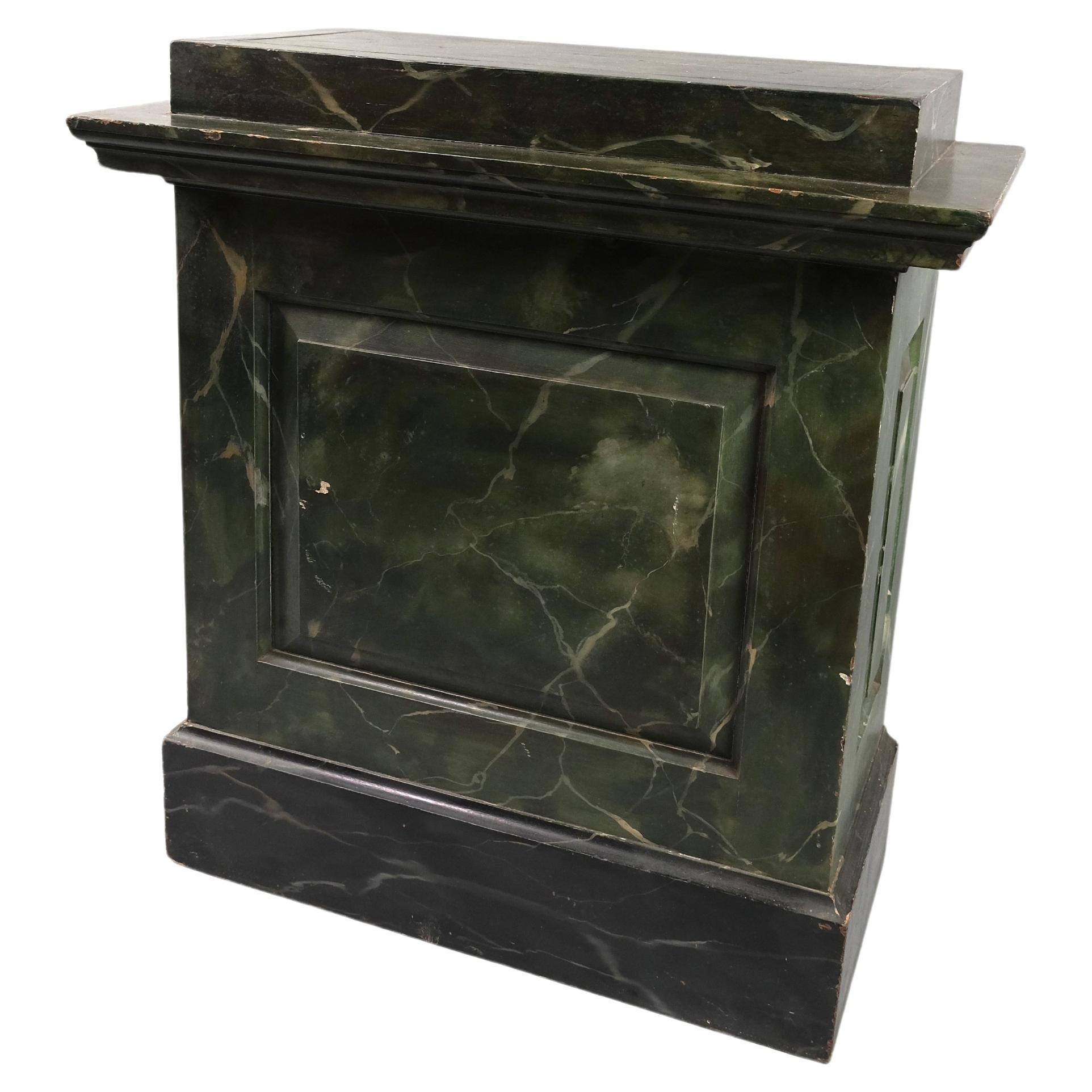Items Similar to Russian Malachite and Pietre Dure Plinths
Want more images or videos?
Request additional images or videos from the seller
1 of 6
Russian Malachite and Pietre Dure Plinths
About the Item
The exquisite art of pietre dure is at its absolute finest in this spectacular pair of Russian ormolu and malachite plinths. True works of art of the Restauration period, these plinths each feature a matching pietre dure mosaic crafted of the finest stones, all chosen to create a sense of depth and dimensionality in the final work. Depicting an onyx vase with tulips, roses, daffodils, magnolia and other flowers, these pietre dure panels are among the finest examples of this ancient art we have seen.
The pietre dure is complemented by malachite panels of the highest quality, exhibiting exceptional depth through its extraordinary cellular structure. Malachite is one of Russia’s most precious stones, and its presence in these plinths indicates commission and ownership by an individual of considerable status. Mounted in an excellent stepped ormolu base, these plinths originally served as bases for vases or candelabra.
The overall execution and appearance of these plinths is very characteristic of the taste associated with the immensely wealthy collector Nicolas Demidoff. As early as 1806, Demidoff had commissioned the Parisian goldsmith Henri August to supply a guéridon; in 1819, he ordered famed French bronzier Pierre-Philippe Thomire to supply mounts for a massive malachite vase (now in the Metropolitan Museum of Art, New York), as well as a console table with legs in the form of Nike. Other commissions included a table given as a gift to Grand Duke Leopoldo II of Florence, now in the Pitti Palace. Demidoff eventually settled in Florence in 1822 and became Russian minister to the Tuscan Court. Elevated to the rank of Count of San Donato by the Grand Duke, he built a magnificent villa at San Donato on the site of lands formerly owned by the Medici. The villa was later inherited by Anatole, his son, Prince of San Donato, and there are records which confirm transactions he had with the Opificio delle Pietre Dure.
The 19th century proved to be the golden age of Russian malachite. The stone became a sign of prestige and a token of wealth, so much so that Russian papers of the time wrote: "To afford having a big piece wrought in malachite is synonymous to owning diamonds." Year after year the Russian (Romanov) treasury paid increasingly unreasonable prices to hoard the best malachite, much of which went into Romanov palaces and extravagant objets d'art. The Hermitage Museum possesses a collection of over two hundred examples of this “palatial” malachite.
A similar plinth is in the Gilbert collection, illustrated in The Art of Mosaics, Selections from the Gilbert Collection by A. González-Palacios et al. A related pair of malachite plinths supporting candelabra is illustrated in Malachite by V.B. Seyonor.
Circa 1825
6 ¾” wide x 7 ¼” deep x 11 ¼” high
Provenance:
Collection of the Cholmondeley Family and Sir Philip Sassoon, Bt., at Houghton Christie’s, London.
- Dimensions:Height: 11.25 in (28.58 cm)Width: 6.75 in (17.15 cm)Depth: 7.25 in (18.42 cm)
- Sold As:Set of 2
- Materials and Techniques:
- Place of Origin:
- Period:
- Date of Manufacture:circa 1825
- Condition:
- Seller Location:New Orleans, LA
- Reference Number:
About the Seller
5.0
Recognized Seller
These prestigious sellers are industry leaders and represent the highest echelon for item quality and design.
Established in 1912
1stDibs seller since 2010
93 sales on 1stDibs
Typical response time: 7 hours
- ShippingRetrieving quote...Ships From: New Orleans, LA
- Return PolicyThis item cannot be returned.
More From This SellerView All
- Micromosaic and Pietre Dure Grand Tour CasketLocated in New Orleans, LAThe time-honored decorative techniques of pietre dure and micromosaic are combined in this rare and exceptionally-crafted Grand Tour casket. Serving as a m...Category
Antique 19th Century European Greco Roman Decorative Boxes
MaterialsStone, Bronze
- Grand Ducal Pietre Dure Console TablesBy Andrea BrustolonLocated in New Orleans, LAAmong the most beautiful examples of hardstone artistry that have ever entered our collection, these important Grand Ducal pietre dure console tables are in a class all their own. Their powerful architectural elegance, impressive size and rarity make them two of the finest hardstone masterpieces ever created and quite possibly the greatest pair of pietre dure tables in existence. With their naturalistically rendered flowers and birds, these tabletop panels showcase the particularly fine quality craftsmanship of the Grand Ducal workshops in Florence during the first quarter of the 17th century. Grand Duke Ferdinando I de Medici, one of the most important personages in the annals of art history, established the Grand Ducal Workshop in 1588. The workshop specialized in the art of pietre dure developed from the ancient art of opus sectile, giving rise to the most luxurious and detailed examples of hardstone artistry ever produced. Its patrons were the Popes and Royals of Europe, and the quality of the objects produced in the workshop is without equal. Typically, because of the high level of workmanship the art form requires, pietre dure plaques were crafted in small sizes. The great majority of known examples of pietre dure are a fraction of the size of our grand tables. The combination of pietre dure and extensive use of other rare decorative hardstones such as lapis lazuli and pietra paesina or “ruin marble” meant that these tabletops were surely produced for a wealthy collector. The tables are further distinguished by their superbly carved bases by Andrea Brustolon, known as the “Michelangelo of wood.” Brustolon was a Venetian wood sculptor known for his exuberant and intricate Baroque furniture. His high Baroque style was influenced by his years studying in Rome, where he was exposed to the sculpture of Gian Lorenzo Bernini. Crafted in the early 18th century, these bases display Brusolon’s unmatched talent for both figural and foliate work, combining cupids, masks and oversized scrolling vines for a grand, ornate effect. Similar furnishings by Brustolon are held in museums worldwide, including the Victoria & Albert Museum, the National Museum of Scotland and the Metropolitan Museum of Art, while the Ca' Rezzonico Museum in Venice features an entire room dedicated to the sculptor. For approximately 150 years, these tables were part of the famed Stoneleigh Abbey collection owned by the Lord Leigh family. This renowned English country estate inspired Jane Austen to write Mansfield Park. Lord Leigh eventually sold the tables at Christie’s London in 1962, and the pair have stayed in the collection of the same Florentine family who purchased them from Christie's until we recently acquired them. Our tables are prominently pictured in the important Saul Levy book Il Mobile Veneziano del Settencento. The pietre dure plaques date circa 1625-1650. The decorative tops likely would have originally been sold with a pair of plain stone columns to display them, and Lord Leigh would have commissioned the custom bases from Brustolon circa 1714 when he added the impressive four-story fifteen-bay Baroque West Wing to Stoneleigh Abbey. A similar single Grand Ducal tabletop is in the United Kingdom’s National Trust Collection, and a smaller tabletop resides in Buckingham Palace. The flower and bird panels in our examples relate to the famous Badminton Cabinet...Category
Antique 17th Century Italian Baroque Side Tables
MaterialsWood
- Pietre Dure And Doré Bronze Box By TahanBy Jean-Pierre TahanLocated in New Orleans, LACrafted by Jean-Pierre-Alexandre Tahan, the esteemed cabinetmaker to Napoléon III, this jewelry box is a remarkable example of 19th-century European artistry. The box, shaped in doré...Category
Antique 19th Century French Empire Jewelry Boxes
MaterialsStone, Bronze
- Russian Malachite and Bronze InkwellLocated in New Orleans, LAMalachite is one of Russia’s most prestigious stones, and its use in the creation of this rare and opulent inkwell indicates commission and ownership by an individual of considerable status. Wonderful doré bronze accents are the perfect complement to the vivid green stone. Two dipping wells and pen tray make this inkwell as functional as it is beautiful, circa 1890. Dimensions: 18 1/4” wide x 11” deep x 5 1/2” high. The 19th century proved to be the golden age of Russian malachite. The stone became a sign of prestige and a token of wealth so much so that Russian papers of the time wrote: “To afford having a big piece wrought in malachite is synonymous to owning diamonds.” Due to malachite's relatively close proximity, Russian tsars could easily obtain the malachite they needed to decorate their lavish palaces, such as the Winter Palace in St. Petersburg, paneling walls and commissioning beautiful inlaid works of art. Year after year the Russian (Romanov) treasury paid increasingly unreasonable prices to hoard the best malachite, much of which went into Romanov palaces and extravagant objects d’art. The Hermitage Museum possesses a collection of over 200 examples of this “palatial” malachite...Category
Antique Late 19th Century Inkwells
MaterialsMalachite, Bronze
- Expanding Jupe Dining Table by Johnstone and JeanesBy Robert JupeLocated in New Orleans, LAThis exceptionally rare circular expanding dining table was designed by Robert Jupe and crafted by the English cabinetmakers Johnstone & Jeanes, successors to Johnstone, Jupe & Co. One of only a handful known from the firm, this table illustrates the Victorian era's quest to combine technical innovation with superb and beautiful craftsmanship. Complete with its original leaves, the table’s circular top is formed from eight separate segments. When the top is rotated, an ingenious swivel mechanism causes the sections to diverge, allowing a set of small or large leaves to be inserted for an adjustable increase in size. The design for the table was patented by Robert Jupe in 1835, who had envisioned “an improved expanding table so constructed that the sections composing its surface may be caused to diverge from a common center and that the spaces caused thereby may be filled up by inserting leaves or filling pieces.” The first of these fascinating tables were created between 1835 and 1840 during his partnership with John Johnstone and their firm of Johnstone, Jupe & Co. in London. Jupe left the company in 1840, after which the firm changed its name due to a new partnership and became Johnstone & Jeanes. The firm would eventually achieve international fame for its remarkable designs, exhibiting a "circular table made on the expanding principle" like this one at the Great Exhibition of 1851. Jupe was not alone in his fascination with combining the technical merits of engineering and mechanics with the more artful pursuit of cabinet making. The first half of the 19th century saw a prolific increase in the popularity of applying new ideas to furniture principles, which allowed furniture to serve many purposes. The resulting “patent” furniture...Category
Antique 19th Century English Victorian Dining Room Tables
MaterialsMahogany
- Regency-Era Card TableLocated in New Orleans, LAThis ingenious late Regency card table was designed with both beauty and entertainment in mind. When not in use, its folded D-shaped top sits against the wall providing an elegant si...Category
Antique Early 19th Century English Regency Game Tables
MaterialsWood
You May Also Like
- Plinth in White Glass and Brass Decorations, Italy, 1980sLocated in London, GBElegant white colour Glass Plinth decorated with brass fixtures. It is an elegant touch in any room to display this beautiful piece of art. Italy, 1980s.Category
Vintage 1980s Italian Mid-Century Modern Pedestals
MaterialsBrass
- Plinth Coco, Made in ItalyBy VG New TrendLocated in Treviso, TrevisoModern sculpture pedestal featured by quilted blue velvet upholstery and golden metal chain at the base, woven with velvet, a clear reference to the world of fashion. Inspired by ...Category
2010s Italian Modern Pedestals
MaterialsWood, Fabric
- Painted green marble plinth/ pedestalLocated in Cheltenham, GBHutton-Clarke Antiques is delighted to present a genuine work of art from the past: an original hand-painted marble pedestal dating back to approximately 1870. This exquisite piece s...Category
Antique Late 19th Century French Neoclassical Pedestals
MaterialsPine
- Crinkle Plinth by Michael GittingsBy Michael GittingsLocated in Geneve, CHCrinkle plinth by Michael Gittings Studio Edition of 2 Dimensions: D 30 x W 30 x H 70 cm Materials: mirror polished stainless steel Michael Gittings Melbourne based designer M...Category
2010s Australian Modern Side Tables
MaterialsStainless Steel
- Plinth in Bordeaux Color Glass and Brass Decorations, Italy 1980sLocated in London, GBElegant bordeaux colour Glass Plinth decorated with brass fixtures. It is an elegant touch in any room to display this beautiful piece of art. Italy, 1980s.Category
Vintage 1980s Italian Mid-Century Modern Pedestals
MaterialsBrass
- Plinth in Turquoise Colour Glass and Brass Decorations, Italy, 1980sLocated in London, GBElegant turquoise colour glass Plinth decorated with brass fixtures. It is an elegant touch in any room to display this beautiful piece of art. Italy, 1980s.Category
Vintage 1980s Italian Mid-Century Modern Pedestals
MaterialsBrass
Recently Viewed
View AllMore Ways To Browse
Plinth Pedestal Base
Art Pedestal Pair
Pair Of Art Pedestals
Matching Pedestals
Antique Selection Of Tables
Collection Malachite
Pair Mounted Pedestal
French Provence Table
Console With Plinth
Malachite 19th Century
Antique Tokens
Medicis Stone
Stone Pedestal Table Base
France And Son Dining Table
Pedestal Base Console Table
Antique Stone Plinths
Antique Stone Plinth
Henri Ii Furniture





